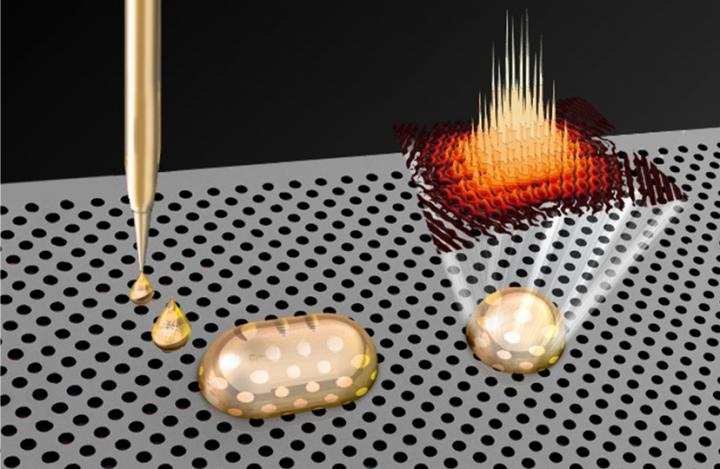Inkjet printing, familiar from millions of desktop printers, is the basis for many new techniques in electronics and biotechnology, using the technology's ability to accurately place small droplets of material to make structures from conducting or semiconductor materials or even living cells. The Cambridge team, from the University's Cavendish laboratory and Hitachi's laboratory in the city, have modified this technology so that it can print dots of ink with optoelectronic properties that can trap and harness light.

The key to the technique, which the team describes in Advanced Materials, is in reducing the size of the droplets to the scale of the wavelength of light. The co-first authors of the paper, Vincenzo Pecunia, a visiting researcher at the Cavendish laboratory, and Hitachi researcher Frederic Brossard, discovered that a new type of printer developed by Pecunia was capable of this resolution.
The printer dispenses ink by a method known as electrohydrodynamic jetting. "Most inkjet printers push the ink through the nozzle by heating or applying pressure, producing ink droplets about the size of the diameter of a human hair," Pecunia explained. The novel printer instead applies a voltage to the ink, forcing it through a much smaller nozzle and producing droplets 10 to a hundred times smaller than those of conventional printers; the droplets have a volume in the femtolitre range, ejected from a nozzle about a micron across.
"Previous efforts to combine these two areas had bumped into the limitations of conventional inkjet printing technology, which cannot directly deposit anything small enough to be comparable to the wavelength of light," said Pecunia. "But through electrodynamic inkjet printing we've been able to move beyond these limitations."
The team used the printer to deposit ink composed of a mixture of a small organic molecule (a spirooxasine) and a polymer (polymethyl methacrylate) dissolved in an organic solvent onto two-dimensional photonic crystals of gallium arsenide. The ink changes the properties of the crystal locally to form a structure known as an optical nanocavity that has the ability to trap light falling on it.
The research represents the first time that high resolution inkjet printing has been successfully combined with optoelectronics. It could be used to print a variety of patterns onto photonic crystals – the team experimented with lines and discs – which would create specific properties.
"This fabrication technique opens the door for diverse opportunities in fundamental and applied sciences," said Brossard. "A potential direction is the creation of a high density of highly sensitive sensors to detect minute amounts of biomolecules such as viruses or cancer cells. This could also be a very useful tool to study some fundamental phenomena requiring very strong interaction between light and matter in new materials and create lasers on demand.”
The crystals are reusable, as the ink can be washed away.




Nanogenerator consumes CO2 to generate electricity
Whoopee, they've solved how to keep a light on but not a lot else.